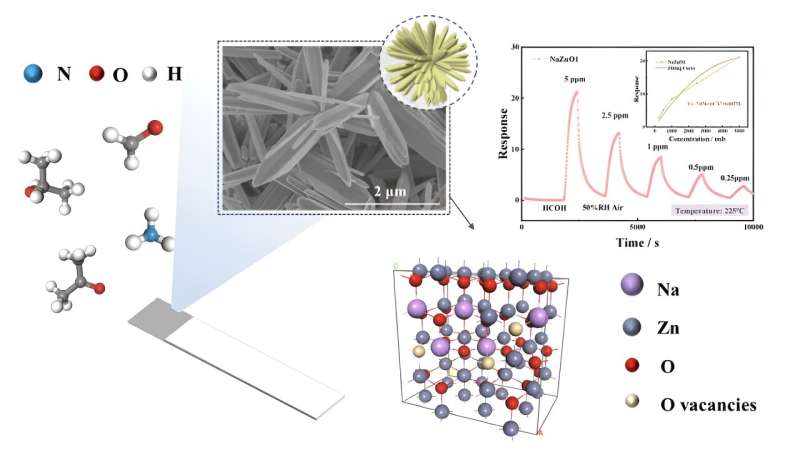Response curves of urchin-like ZnO and NaZnO1 sensors to 5 ppm HCHO at 225℃, 50% RH. Credit: Journal of Advanced Ceramics, Tsinghua University Press
Developing high-performance gas sensors for the detection of lung cancer markers at low concentrations is a crucial step towards achieving early lung cancer monitoring through breath tests. Metal oxide semiconductors (MOS) have long been sensitive to volatile organic compounds (VOCs), demonstrating excellent performance characteristics.
However, the concentration of characteristic VOCs for lung cancer detection based on breath tests (such as formaldehyde, isopropanol, acetone, and ammonia) is typically less than 1 ppm. Most metal oxides struggle to respond at such low concentrations, which can impact the early diagnosis of lung cancer.
Gas sensors based on metal oxide semiconductors (MOS) have shown promise in detecting VOCs, but their effectiveness at very low concentrations remains a challenge. The concentration of lung cancer biomarker VOCs (such as formaldehyde, isopropanol, acetone, and ammonia) in breath samples are often below 1 ppm, making it difficult for most metal oxides to generate a high response. Overcoming this limitation is essential for improving early lung cancer diagnosis.
To address the above-mentioned challenges, a team of material scientists led by Professor Chao Zhang from the Institute of Surface Engineering at Yangzhou University, China, recently outlined the development of alkali metal ion-doped ZnO nanoneedles, specifically doped with sodium (Na) ions, assisted by citric acid. This approach aims to enhance the performance of metal oxide-based electrochemical gas sensors, enabling high responsiveness for detecting VOCs at low concentrations.
The team published their study in the Journal of Advanced Ceramics.
"Metal ion doping is effectively used to improve the sensing performance of ZnO. Specially, ZnO is highly sensitive to alkali metal elements and exhibits good doping stability, which will make it easier for ions to be doped into the lattice of ZnO, leading to the formation of more oxygen vacancies," said Chao Zhang, senior author of the study.
"In addition, the solubility of alkali metals in the ZnO lattice is closely related to the radius of the dopant ions, and a low concentration of doping will make it difficult to generate the acceptor energy level. Na ions have a higher radius than Zn ions and show high solubility. It is favorable to improve the stable concentration of Na doping, leading to the formation of the shallow acceptor level," Zhang added.
The researchers used a solvothermal method to fabricate three-dimensional nanoneedles of Na-doped ZnO with different amounts of citric acid. The team evaluated the gas sensing properties of Na-doped ZnO to lung cancer biomarkers at sub-ppm concentrations, the preparation method was optimized, and the optimum ratio of citric acid and Na ion was obtained.
The experimental showed that the Na-doped ZnO gas sensor exhibited a high sensitivity (~ 21.3@5ppm/50% RH) to lung cancer biomarker VOCs at low concentrations, which is 7 times higher than that of pure ZnO. In addition, the resulting gas sensor exhibited excellent selectivity for formaldehyde, good humidity resistance, and reliable repeatability at an optimal temperature of 225° C.
In addition, the researchers explained the mechanism of the improved gas-sensitive performance. the Na ions replaced the Zn ion centers to produce more oxygen vacancies, which increased the concentration of oxygen defects (Ov= 20.98%), and the target gas adsorption sites were increased.
Moreover, Na was introduced as an impurity energy level to become the acceptor energy level close to the top of the valence band, which was in contact with the valence band of the pure ZnO. This lowered the width of bandgap, and further stimulated the electron leaps, thus improving the gas-sensitive performance.
More information: Yiwen Zhou et al, Urchin-like Na-doped zinc oxide nanoneedles for low-concentration and exclusive VOC detections, Journal of Advanced Ceramics (2024). DOI: 10.26599/JAC.2024.9220873
Provided by Tsinghua University Press
























